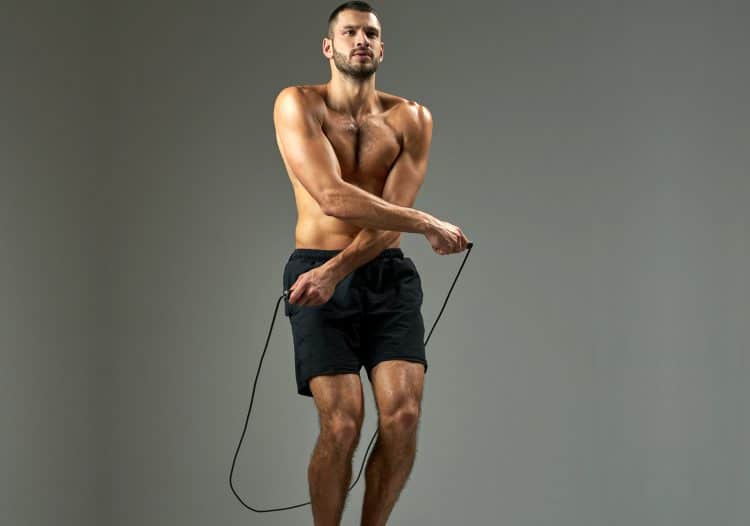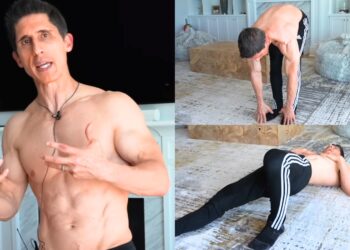Warming up before a workout is one of the most overlooked aspects of resistance training. It is much more prevalent on upper body training days as many lifters skip an upper body warmup and head straight to the free weight section.
If your warm-up before a resistance training session is limited to a jog on the treadmill, you could be setting yourself up for an injury — especially if you are an advanced lifter.
Even if the goddess of luck is on your side and you have never encountered an injury while training without warming up, you are putting unnecessary strains on your muscles and joints.
An effective upper body warmup routine could include bodyweight and resistance band exercises. A good warmup ritual prepares your body and mind for your workout.
Benefits of Upper Body Warmup
Warmup exercises do much more than help you loosen up before a workout. Benefits of upper body warmup include:
1. Lower Risk of Injury: Research suggests that warming up your muscles can help them relax and prime them for resistance training. (1)
Level Up Your Fitness: Join our 💪 strong community in Fitness Volt Newsletter. Get daily inspiration, expert-backed workouts, nutrition tips, the latest in strength sports, and the support you need to reach your goals. Subscribe for free!
2. Increased Blood Flow and Oxygen: Warming up before a workout pushes more blood into your target muscles, which helps your muscles receive the nourishment they need before an intense workout.
3. Better Performance: Studies show that warming up before a workout helped a group of men perform better than subjects who did not warm up. (2)
4. Improved Flexibility: It is no secret that an upper body warmup routine can help improve your flexibility. On top of that, warming up and stretching before a workout aid in improving your range of motion.
5. Lesser Strain on Muscles and Joints: Warming up before a workout can help get rid of muscle and joint stiffness. It results in moving more easily and with less pain or stiffness.
6. Activate Under-Utilized Muscles: Smaller upper body muscles groups like posterior deltoids and lower back can be hard to engage during your lifts. Optimal recruitment of these stubborn muscle groups can help get the most out of your training while reducing your chances of injury.
Types of Warmup Routines
The two types of warmups you can do include:
1. Dynamic Warmup
A dynamic warmup gets your muscles and joints loose for your workout. It focuses on improving speed, agility, and acceleration. Dynamic stretching involves active tightening of your muscles and moving your joints through their full range of motion throughout the stretch.
Dynamic warmups are functional and sport-specific movements that help in increasing muscle temperature and decreasing muscle stiffness.
2. Static Warmup
Static stretching involves standing, sitting, or lying still and holding a single position for a period of time — without movement. This allows your muscles to loosen up while increasing your flexibility and range of motion.
While dynamic stretching is great for performing at the beginning of your workouts, you should spend at least 5-10 minutes at the end of your workouts static stretching. Remember, cooling down after a workout is as important as warming up.
Check Out: Calories Burned Stretching Calculator
Upper Body Warmup Principles
To make the most of your warmup routine, you should adhere to the following principles:
1. Do Not Rest Between Sets
Do not treat your warmups like your training sets. Not resting between sets will help increase your core body temperature and blood circulation. Not to mention, keeping it moving will help save time and build focus.
2. Focus on Following a Full Range of Motion
Performing the warmup exercises with a full range of motion will help loosen up your joints and establish a mild-muscle connection. You should also practice contracting your muscles with every rep. The muscle memory from these warmup exercises will carry forward to your working sets.
3. Follow Progression
The goal here is not to annihilate your muscles. You should always keep your warmup routine light. Start your warmups with the easiest exercises as your body requires time to increase the blood flow to your working muscles. Give your muscles the time to prepare for the mayhem.
The Most Effective Warmup Routine
An effective warm-up routine involves:
1. Do a Full Body Dynamic Workout Routine
It does not matter if you are training your upper or lower body, you should always perform a full-body dynamic workout routine before starting training.
Why is that, you ask?
Some upper body exercises require lower body engagement (eg – bent-over rows). Similarly, you cannot eliminate upper body recruitment in lower body exercises like the squat.
So, you need to ensure that you are fully warmed up before every workout session. However, since your complete warmup regimen will last 10 minutes, the full-body dynamic routine should not go beyond 3-4 minutes.
2. Perform an Upper Body Warmup Routine
After you are done with the full-body warmup routine, you should focus on getting your upper body ready for the workout. The upper-half warmup regimen will include full range-of-motion exercises and mobility stretches for the chest, back, arms, core, and shoulders.
3. Exercise Specific Warmup
If you still have time left, you could round up your warmup routine by performing light warmup sets for every exercise you are going to do that day.
Level Up Your Fitness: Join our 💪 strong community in Fitness Volt Newsletter. Get daily inspiration, expert-backed workouts, nutrition tips, the latest in strength sports, and the support you need to reach your goals. Subscribe for free!
Alternatively, you could skip this part and perform one light warmup set of every exercise before doing the working sets. Example: If you are supposed to do three sets on the bench press, you should begin the exercise by performing a light warmup set — let’s call this ‘set zero’ — with not more than 50% of your usual weight.
Sample Upper Body Warmup Routine
Many lifters omit a warmup routine simply because they lack knowledge. Doing the exercises mentioned below will ensure your upper body (chest, shoulders, back, arms, and core) is ready for your workout.
Make sure you complete the following routine in under 10 minutes:
- Jumping Jacks: 2 minutes
- Downward Dog: 3 sets of a 10-second hold
- Hip Rotation: 2 sets of 10 reps (each side)
- Arm Circle: 2 sets of 10 reps (each direction)
- Resistance Band Pull-apart: 2 sets of 10-20 seconds
- Incline Push-up: 2 sets of 10 reps
- Bear Hold: 2 sets of a 10-second hold
Note: If your warmup routine is taking longer than 10 minutes, you could shorten the duration by cutting down the number of sets.
Best Upper-Half Warmup Exercises
1. Jumping Jacks
It is a full-body exercise that will get your blood pumping. Jumping jack is a basic exercise almost everyone has done as a child.
How to do jumping jacks:
- Stand upright with a shoulder-wide stand and your arms at your sides.
- Bend your knees slightly, and jump into the air.
- As you jump, spread your legs to be more than shoulder-width apart. Stretch your arms out and over your head, so your hands almost clap together.
- Jump back to starting position.
- Repeat.
2. Downward Dog
The downward dog — sometimes referred to as a downward-facing dog or down dog, is a standing yoga pose that helps stretch your whole body.
How to do a downward dog:
- Get down on all fours so that your hands are under your shoulders.
- Your hips should be above or slightly before your knees.
- Lift your knees and tuck your toes against the mat or floor.
- Use the leverage to extend your legs and lift both knees into the air.
- Extend and lengthen your spine while pressing through your palms and balls of feet.
- At the top, your upper and lower limbs should be fully extended, and your body should resemble an upside-down “V.”
- Pull your pelvis up toward the ceiling.
- Hold for 10 seconds while making sure you breathe properly.
- Slowly return to the starting position and repeat for reps.
3. Hip Rotation
Hip rotation is the final full-body focused exercise on the list. It is a great exercise to loosen up your glutes, hamstrings, quadriceps, and lower back.
How to perform hip rotation:
- Stand upright with a shoulder-wide stance.
- Bend your arms and place your hands behind your head.
- Slowly lift your right left off the floor and bring it towards your chest.
- As your knee reaches chest level, circle it across your body, then back down to the starting position.
- Repeat on the left leg.
- Alternate between legs to perform the recommended reps.
4. Arm Circle
Arm circle is the first dedicated upper body warmup exercise on the list. It improves your shoulder mobility and function.
How to perform arm circle:
- Stand with your feet shoulder-width apart.
- Extend your arms at your sides so they are parallel to the floor.
- Circle your arms forward using small controlled motions, gradually making the circles bigger until you feel a stretch in your biceps.
- Reverse the direction of the circles after drawing 10 circles.
5. Resistance Band Pull-apart
The resistance band pull-apart is one of the most underutilized upper body warmup exercises. It can help you work your chest, back, shoulders, and arms.
How to perform resistance band pull-apart:
- Stand upright with your feet shoulder-width apart.
- Hold one end of a resistance band in each hand.
- Raise your arms straight in front to shoulder height, palms down, with your hands about six inches apart.
- The band should have a small amount of tension, but it should not be taut.
- Pull the band apart by extending your arms wide to each side until your upper body is in a T position.
- Pause and contract your back and shoulders when the band is fully extended.
- Return to starting position.
- Repeat.
6. Incline Push-up
Although this move primarily targets your pecs, you will also feel your back, shoulders, core, and triceps.
How to perform incline push-up:
- Get into a high plank position with your hands placed on a box, bench, or step.
- Your hands should be shoulder-width apart and placed under your shoulders.
- Make sure your body is in a straight line throughout the exercise. Keep your core and glutes engaged.
- Bend at your elbows to lower your chest toward the bench.
- Push through the palms of your hands to straighten your arms.
- Repeat.
7. Bear Hold
A bear hold — also known as a bear plank — might look harmless, but it will set your core on fire. It is a great exercise to perform at the beginning of a workout as it will remind you to keep your core contracted throughout the training session.
How to perform bear hold:
- Get into an all-fours position with your wrists under your shoulders and knees directly under your hips.
- Tuck your toes and lift your knees a few inches off the floor.
- Your back should be flat, and weight evenly distributed on your hands and toes.
- Hold for 10-20 seconds.
- Return to starting position.
- Rest for five seconds and repeat.
Alternative Upper Body Warmup Exercises
Here are a few other upper body stretching alternatives that can help you loosen up for your workouts:
1. Doorway Chest stretch
It is a great warmup exercise to perform at the beginning of a chest workout.
How to perform doorway chest stretch:
- Stand in an open doorway.
- Raise your left arm to the side, bent at a 90-degree angle.
- Rest your palm on the door frame.
- At the starting position, your upper arm should be parallel to the floor and the lower arm perpendicular.
- Slowly lean forward until your feel a stretch in your shoulder and pec.
- Hold for 10-20 seconds.
- Return to the starting position.
- Switch sides.
Pro tip: You could also use a pole or a cable pulley machine for this exercise.
2. Overhead Lat Stretch
Stretching the lats at the beginning of a back workout can help you establish a better mind-muscle connection.
How to perform overhead lat stretch:
- Grab a stable object — near your head height — with an overhand grip.
- While maintaining a neutral spine, extend the same side leg behind you as you lean forward until you feel a stretch in your lats.
- Keep your hips square throughout the exercise.
- Work through the tension in this position by internally and externally rotating your torso.
Next Read: Mobility Training for Bodybuilders, Powerlifters, and Weightlifters
Wrapping Up
Warming up before strenuous physical activity is non-negotiable. It does not matter how pressed you are for time — you should not proceed with a resistance workout without a 5-10 minute lower or upper body warmup.
Every time you feel like saving 10 minutes by skipping a warmup session, know that you are throwing caution to the wind and risking an injury.
References
- LaBella CR, Huxford MR, Grissom J, Kim K-Y, Peng J, Christoffel KK. Effect of neuromuscular warm-up on injuries in female soccer and basketball athletes in urban public high schools: cluster randomized controlled trial. Arch Pediatr Adolesc Med. 2011;165(11):1033-1040.
- Fradkin, AJ, Zazryn, TR, and Smoliga, JM. Effects of warming-up on physical performance: a systematic review with meta-analysis. J Strength Cond Res 24(1): 140–148, 2010.









